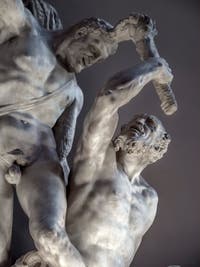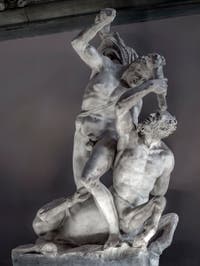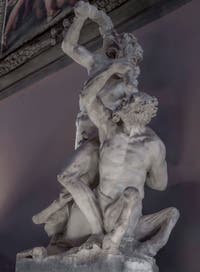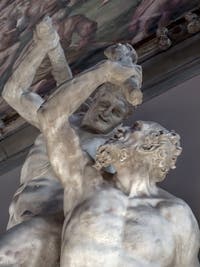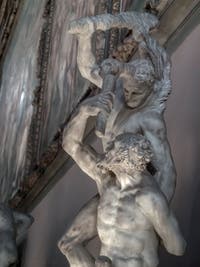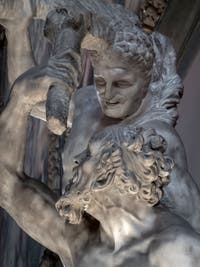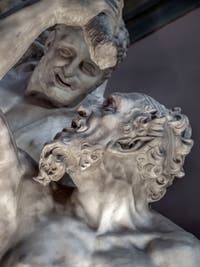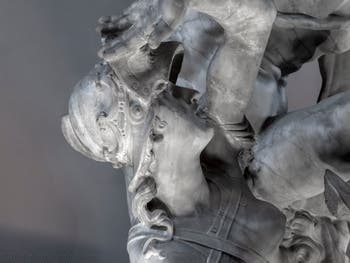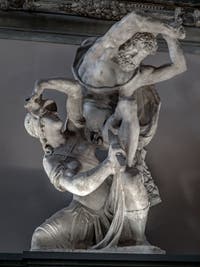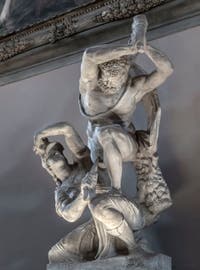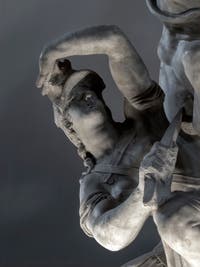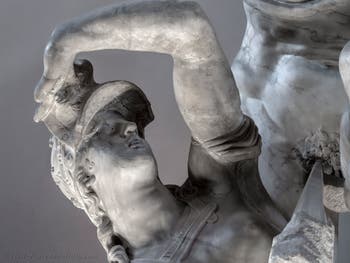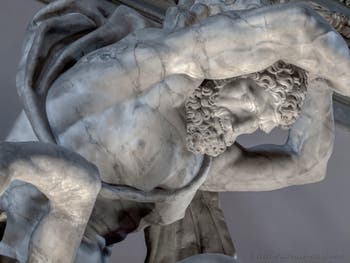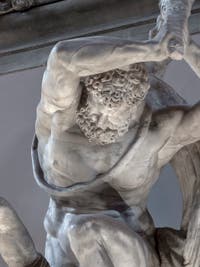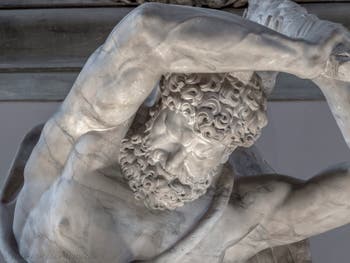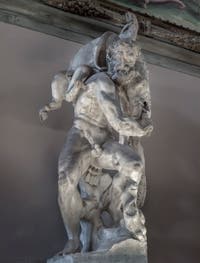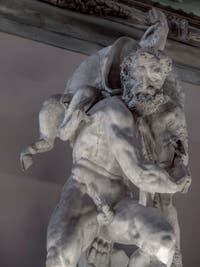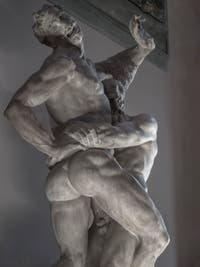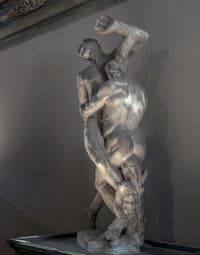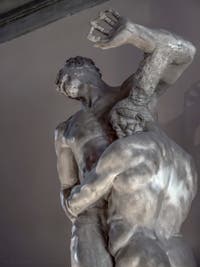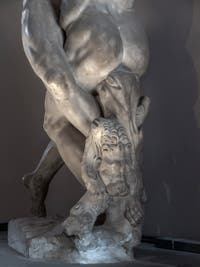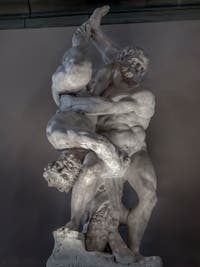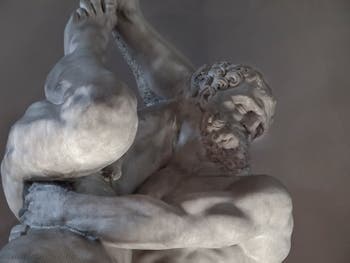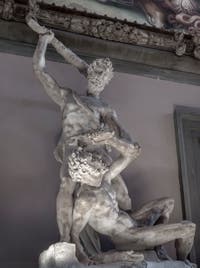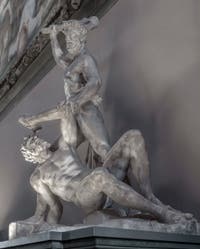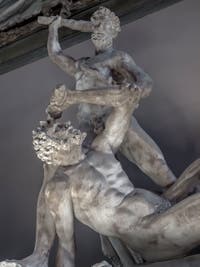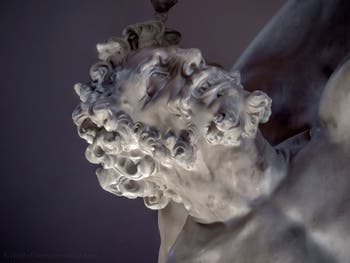Palazzo Vecchio Art Story | Location | Opening Hours Tickets | Authorizations
Art Story Five-Hundred | Tower | Vasari Halls | Dante Mask | Ghirlandaio | Bronzino Sarto Daddi | Salviati | Cortile
Five-Hundred Hall Hall and Ceiling | Ceiling Paintings | Pisa War | Siena War | Sculptures
Sculptures Michelangelo | Giambologna | Vincenzo de Rossi
Vincenzo de Rossi “The Labours of Hercules” Hall of the Five Hundred of Palazzo Vecchio in Florence, Italy
Vincenzo de Rossi (1525-1587) was a pupil of the sculptor Baccio Bandinelli (1488-1560), who had made much of the sculptures in the Hearings room located at the back of the Hall of the Five Cents, as well as the marble choir of the Basilica Santa Maria del Fiore.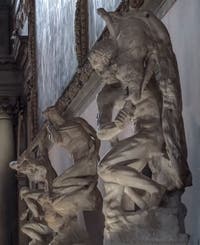
Boar of Erymanthus After Bandinelli's death, Vincenzo de Rossi had returned to Rome to continue his career as a sculptor.
But he missed Florence, and he asked Duke Cosimo I de Medici to allow him to return to Florence and finish Bandinelli's work in the Hall of Five Hundred.
Cosimo I de Medici knew the talent of Vincenzo de Rossi and offered him to return to Florence in 1561 and let him use a workshop at the Opera of Santa Maria del Fiore where the sculptures of the Duomo were made.
In this same workshop were also unfinished sculptures by Bandinelli.
In 1562, Cosimo I de Medici commissioned Vincenzo de Rossi the sculptures of the “Labours of Hercules”, which can be seen in the Hall of the Five Hundred of Palazzo Vecchio.
In 1568, the sculptures of “Hercules and Cacus” and “Hercules killing the Centaur Nessus” were completed, and the others were being finished.
The Labours of Hercules in the Florentine tradition
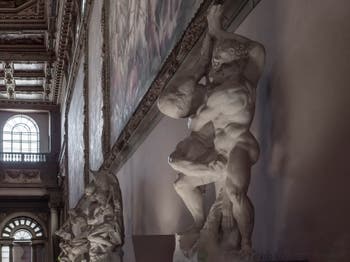
Hercules and Diomedes Hercules was part of Florentine iconography from the 13th century.
At that time, the seal of the city of Florence was already in its effigy, and the hero was also represented in the marble sculptures of the Duomo's door frame della Mandorla.
Hercules was considered to be the one capable of countering the wills of tyrants and various oppressors, just like David in the face of Goliath.
The Florentines, therefore, associated the image of the hero's resistance to that of Florence compared to all those who wished to dominate it.
The Medici themselves had commissioned works by the mythical hero relating the labours of Hercules to Pollaiuolo, including “Hercules and Antaeus" and “Hercules and the Hydra”, which can be seen in the Uffizi Gallery.
The Medici also commissioned the sculptor Baccio Bandinelli a statue of Hercules, to greet Pope Medici Leo X at his solemn entrance to Florence in 1515.
A sculpture that can always be seen in Piazza della Signoria, in front of the Palazzo Vecchio.
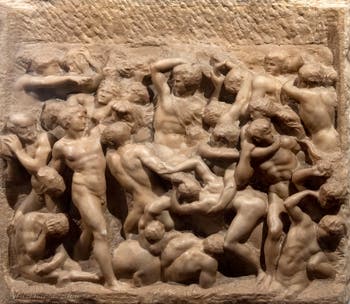
Michelangelo, Hercules This desire to associate the image of Hercules with that of Florence was confirmed by Cosimo I de Medici and the sculptures he commissioned from Vincenzo de Rossi.
For the Medici, Hercules represented the invincible hero capable of overcoming the adversaries suffered by the Medici family over the centuries, exiled, hunted, but still able to regain power by triumphant of their opponents.
Duke Cosimo I de Medici politically used the myth of Hercules for his benefit to show the Florentines the importance to bear on traditional values and... to consolidate his own power.
A political thought perfectly highlighted in the sculptures of the works of Hercules made by Vincenzo de Rossi show us a mighty Hercules, without any hesitation or mercy for his opponents.
Vincenzo de Rossi “Hercules kills the Centaur Nessos” Hall of the Five Hundred of Palazzo Vecchio in Florence
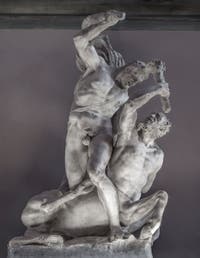
Hercules kills Nessos Sculpture - Marble - Height 276 cm - 1568
After his marriage to Dejanire, the daughter of King Aeneas, Hercules left the king's court with the young woman, and on the way, found herself before the river Eventos.
The centaur Nessos then offered Hercules to carry his wife on his shoulders to help him cross the river, which Hercules accepted.
But the centaur could not resist the charms of Dejanire and, barely arrived on the other bank, he tried to rape her.
Hercules, hearing the cries of despair of his wife, caught up with the centaur Nessos and, furious, killed him immediately.
According to legend, Nessos was killed by the arrows of Hercules, poisoned with the venom of the Hydra of Lerna.
Still, Vincenzo de Rossi preferred to choose the version according to which Hercules kills Nessos with a club, a version more suitable for sculpture.
Vincenzo de Rossi “Hercules kills Hippolytus the Queen of the Amazons” Hall of Five Hundred of Palazzo Vecchio in Florence
Sculpture - Marble - Height 263 cm - 1562-1584This episode corresponds to Hercules's ninth labour.
The niece of Hercules, Admete, wanted to own the famous golden belt of the Queen of the Amazons.
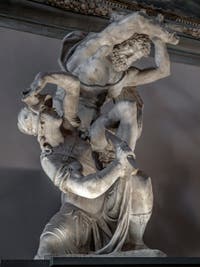
Hercules and Hippolytus Eurystheus, Admete's father, asked Hercules to take over the said belt.
Let us recall that it was Eurystheus, at the request of the gods, who ordered Hercules to carry out his twelve labours.
According to the versions, it is Hippolytus's sister who is killed.
According to others, it is the Queen herself who is killed by Hercules.
However, what is certain is that the endeavour, which had to limit itself to taking the belt alone, was disturbed by the intervention of the goddess Hera.
Hera alerted the Amazons by making them believe that Hercules wanted to take the Queen away and that his men wanted to kill the Amazons.
As a result, while Hercules was asking Hippolytus to give him her belt in exchange for gifts, the Amazons, believing in Hera's word, attacked the hero to kill him.
Hercules then thought he had been caught in a trap set by Hippolytus and, wishing to take revenge on this betrayal, killed the Queen of the Amazons.
In the statue of Vincenzo de Rossi, we see Hercules killing Hippolytus with the help of his club while she protects herself as she can and even try to hurt the hero with a dagger.
Vincenzo de Rossi “Hercules captures the Boar of Erymanthus” Hall of the Five Hundred of Palazzo Vecchio in Florence
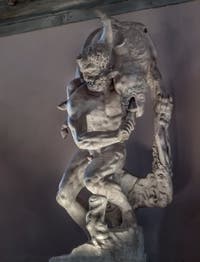
Boar of Erymanthus Sculpture - Marble - Height 290 cm - 1560-1570
This episode corresponds to Hercules's fourth labour.
He had to capture a giant wild boar who lived on the slopes of Mount Eritmantha in Arcadia and caused significant damage to surrounding crops.
On his way to Arcadia, Hercules was warmly received by Centaur Pholus, who made the mistake of letting Hercules drink the wine belonging to the centaur community.
These, attracted by the smell of wine, decide to kill Hercules for this sacrilege.
Hercules defends himself and kills several centaurs, including the good Pholus.
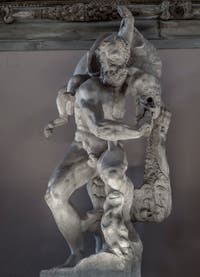
Boar of Erymanthus One of Michelangelo's first sculptures, “Hercules and the Centaurs” which can be seen in Florence at the Museum of the House of Michelangelo, relates to this episode.
After this unfortunate episode, Hercules continued his journey and began research on the snowy slopes of Mount Erymanthe to find the famous giant boar.
The wild animal was not an easy prey; it was at the end of many days of pursuit, cornering the wild boar to the top of the mount in the eternal snow that Hercules was finally able to seize it.
Here we see the wild boar securely held on Hercules's shoulders with one hand while, on the other hand, he drives a stick into its mouth to prevent it from biting him.
It is said that when Hercules appeared before Eurystheus, the latter was so terrified by the animal that he went to hide in a large jar of wine!
Vincenzo de Rossi “Hercules suffocates Antaeus” Hall of the Five Hundred of Palazzo Vecchio in Florence
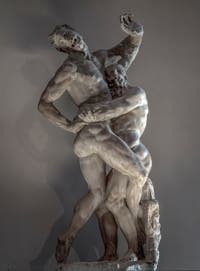
Hercules and Antaeus Sculpture - Marble - Height 229 cm - 1562-1584
This episode corresponds to Hercules's eleventh labour, which consisted of making a journey into the afterlife to seize the golden apples of the Garden of the Hesperides.
On her way to the famous garden, Hercules must pass through Libya where Antaeus reigns, a colossus who draws his strength from his mother Gaia, the Earth.
King Antaeus is known for his cruelty, leading him to collect the skulls of travellers he enjoys killing when they pass through his country.
Hercules is therefore forced to face the colossus Antaeus to continue his journey to the garden of the Hesperides. The fight between the two men surprises Hercules.
Indeed, every time Antaeus finds himself thrown to the ground, Hercules finds that he rises even stronger than before.
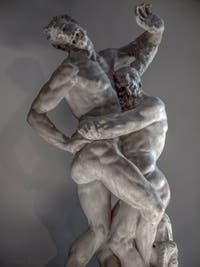
Hercules and Antaeus The hero then understands that it is the mother of Antaeus, the Earth Gaia, who gives back strength to Antaeus every time her son comes into contact with her.
Hercules then changes tactics and raises Antaeus by taking it by the waist, thus preventing him from coming into contact with the earth.
Hercules only has to tighten his enemy more and more strongly in his powerful arms until the latter, deprived of strength, ends up stifling and rendering the soul.
It is this precise action that represented Vincenzo de Rossi.
His sculpture shows us an Antaeus much greater than Hercules but powerless against the strength of the hero who grinds his loins while lifting him off the ground.
Vincenzo de Rossi “Hercules punishes King Diomedes” Hall of Five Hundred of Palazzo Vecchio in Florence
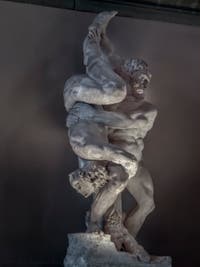
Hercules and Diomedes Sculpture - Marble - Height 295 cm - 1562-1584
This episode corresponds to the eighth labour of Hercules in which the hero must steal the four carnivorous and anthropophagous mares of the son of Ares God of War, King Diomedes.
Hercules easily finds the mares and takes them away, and entrusts them to his friend Abdere, recommending that he be careful because these mares preferably eat men!
Meanwhile, the men of Diomedes realized the disappearance of mares and, accompanied by their king, attacked Hercules and his friends.
Barbarians are easily defeated by Hercules, and Diomedes is also captured.
But the joy of victory is short-lived when the hero finds that his friend Abdere has disappeared, devoured by the king's mares.
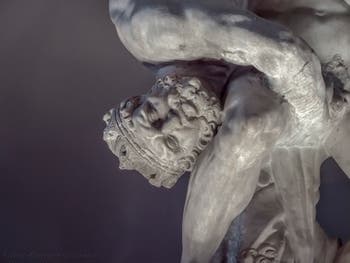
Hercules and Diomedes Hercules's answer is fierce.
He seized King Diomedes and throws him into the trough of his own carnivorous mares so that he might suffer the same fate as all the travellers he had made atrociously die there.
In the sculpture of Vincenzo de Rossi, we see Hercules, who grabs Diomedes with his head down, ready to throw him into the trough of mares while Diomedes tries to clasp to Hercules, one of his hands encloses the sex of the hero.
Vincenzo de Rossi “Hercules and Cacus” Hall of the Five Hundred of Palazzo Vecchio in Florence
Sculpture - Marble - Height 255 cm - 1568This episode corresponds to Hercules's tenth labour of stealing in Andalusia, the most beautiful herd in the world, to the monster Geryon, the son of the titan Ocean.
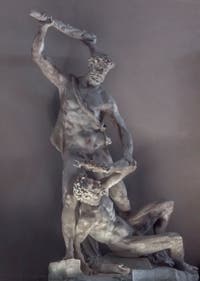
Hercules and Cacus This impressive monster has the particularity of having three busts, three heads, and six arms.
This does not prevent Hercules from killing him easily by crushing his heads with his club.
After his crime, Hercules seized the herd and takes him on a long journey from Spain to Greece.
A journey in which Hercules must fight all those who wish to seize his flock.
The hero manages to thwart the plans of most of the different thieves until he arrives in Tuscany.
As Hercules fell asleep near the Tiber, the giant Cacus, the son of Vulcain, takes advantage of the hero's sleep to steal four pairs of oxen from him.
Cacus, to cover his escape and theft without a trace, removes the oxen by making them walk backwards by pulling them by the tail.
But this subtle strategy does not prevent Hercules from finding the thief and the beasts whose moos Hercules hears.
Cacus had hidden the stolen oxen in an Aventine cave and closed the entrance to the cave with a huge rock held by chains forged by his father, Vulcain.
Hercules has no difficulty breaking the rock and punishes Cacus by killing him with a mass blow.
Sculptures Michelangelo | Giambologna | Vincenzo de Rossi
Five-Hundred Hall Hall and Ceiling | Ceiling Paintings | Pisa War | Siena War | Sculptures
Art Story Five-Hundred | Tower | Vasari Halls | Dante Mask | Ghirlandaio | Bronzino Sarto Daddi | Salviati | Cortile
Palazzo Vecchio Art Story | Location | Opening Hours Tickets | Authorizations
Back to Top of Page


